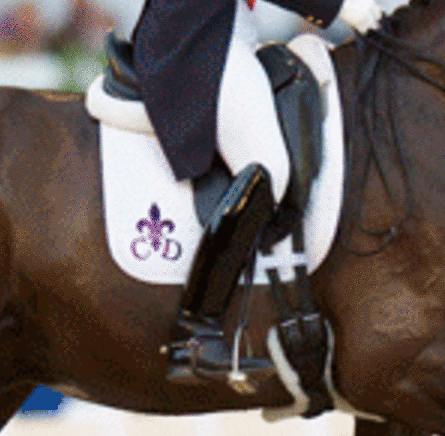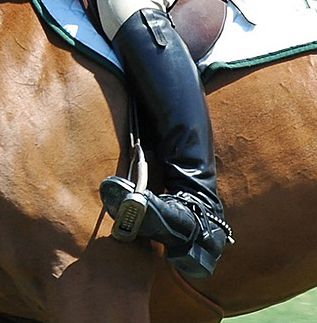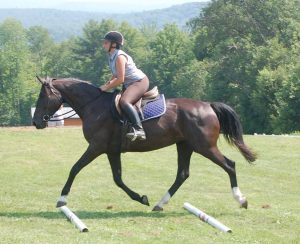
Most riders will agree that, ideally, we ride with our “seat”, from our core with our arms and legs being extensions of that core. Most of us spend a large amount of our time riding in a saddle with stirrups. So if we are riding with our core, what is the purpose of those stirrups? How can we use our stirrups well while still riding from our seat/core? We want our stirrups to work for us and for our horse/human partnership.
First, we want our feet to sit nicely in the stirrups without bracing. Bracing in the stirrups creates a brace against the horse and against our own relaxation in the saddle. There IS such a thing as too much heels down. I encourage riders to explore the difference between drawing their toes up and pushing their heels down. Try it while standing in your living room or in the barn aisle or wherever you happen to be reading this. Place your feet shoulders’ width apart and push into your heels. Feel the muscles that activate and the direction your body would like to move.

Okay, shake that off and now place your feet shoulders’ width apart and just draw your toes up. Feel those muscles and how your body is positioned.
Next time you go out with your horse, play with both as you sit in the saddle and in half seat position; find what feels balanced. For most of my riders, the toes up approach is best. I do have a few riders who tend to ride with legs too far back and find themselves leaned forward precariously, these folks actually need to practice the heels down approach in order to allow their leg to come forward and their upper body to straighten. I have found a lot of riders have adopted an extreme heels down position in order to compensate for bracey/fast/or unpredictable horses; unfortunately, this creates a brace in the rider that encourages the horse to be less relaxed and more prone toward brace rather than relaxation.
When we use stirrups, we want them to be like the ground under our feet as we stand; a solid foundation where we can be comfortable.
Another important factor with our stirrups is that our feet should be evenly standing across them. Often riders will put too much weight to the outside or inside. Let’s face it, we often do this standing on the ground; just check the wear of your boots and you will see if you put more weight on the insole or on the outside of your feet.
When riders put a lot of weight on the inside of their feet, I will see the bottoms of their boots as they ride by. This can be accompanied by knees pinching the saddle rather than a leg draped straight and wrapping around the horse.

On the other hand, if riders push too much to the outside of the stirrup, I will often see air between their knees and the saddle and lower legs gripping. Often, the toes will also turn out when this is an issue.
Both of these foot positions leave the rider less secure in the saddle. They actually take away from our ability to ride from our seat.
It is important that we fix these types of issues from the hip/whole leg so we don’t put undue stress on our knees or ankles by forcing them into a particular position.
Now we get to stirrup length. Many riders will lengthen stirrups to make their leg “longer” and then ride with toes down and reaching for the stirrups. It’s important to realize that just lengthening stirrups doesn’t automatically open the hip flexors and reaching for too long stirrups can cause all kinds of issues in the core of the body and ability to connect with the rhythm of the horse.

Also, it’s important that the stirrups be correct for the job at hand. Jumping stirrup lengthen is shorter than flat work stirrup length. A casual trail ride on a trusted horse can include longer stirrups than a working dressage ride. In general, flat work stirrups would touch just below the ankle bone; a length which may change as hip flexors open after a warm up.
Our stirrups should offer a foundation that enhances our ride and allows us to focus on that core posture which will give us the independent seat we desire.

